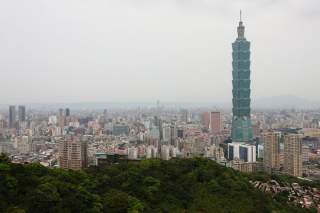Taiwan: Small but Hardly Insignificant
Time to focus on one of the Asia pivot's biggest fans.
President Obama didn’t visit Taiwan on his recent swing through East Asia, and commentary on his trip has almost completely ignored the island 100 miles off China’s coast. Yet visitors find it difficult not to be impressed by the resolve and resiliency of the 23 million people who live on Taiwan, and who are among the region’s biggest fans of Obama’s “pivot” or “rebalance” to the Asia-Pacific.
Taiwan sends mixed signals to its visitors. Newspaper headlines and television talk shows shout of political gridlock, economic malaise, and vulnerability before the Chinese juggernaut. The two principal political parties seem no more able than Republicans and Democrats in this country to work for the common good. Last month protesters occupied the parliament building for twenty-four days. No sooner had that group disbursed than a new set of demonstrators emerged, surrounding government buildings and blocking traffic in the Taiwanese capital of Taipei.
Economic anxieties are also palpable. Many young people worry whether they will be able to find good jobs and affordable housing. As in the United States, many are skeptical about the purported virtues of globalization. Taiwan’s growing economic dependence upon China also sparks uneasiness.
Yet beneath the tumult of messy politics and economic anxiety lies a reassuring picture of political vibrancy, economic vitality, and an admirable determination to face the future forthrightly. Compared to the one-party authoritarianism of their recent past, Taiwanese have reason to take pride in their robust democracy. While wages are stagnant and housing dear, GDP growth this year is expected to reach 2.82 percent, its strongest showing in three years. Taipei has recently signed high-end, free-trade agreements with New Zealand and Singapore that point to additional economic progress.
Yes, China continues to create uncertainty. Yet tensions between Taipei and Beijing are at an all-time low. Whereas there were no direct airline flights between the two sides of the Taiwan Strait as recently as 2007, today 828 flights cross the Strait each week, linking ten cities in Taiwan with fifty-four in China. Similarly, the number of Chinese tourists visiting Taiwan jumped by more than 900 percent between 2007 and 2013. This past February saw the highest level of official contact between the two sides since the end of the Chinese civil war more than sixty years ago.
Taiwan badly wants more U.S. arms and other defense equipment. Yet according to the nonpartisan Congressional Research Service, it has fared quite well in this regard in recent years, with more than $20 billion of U.S. arms sales since 2008. Last fall Taipei took delivery of the first of twelve P-3C Orion antisubmarine aircraft from the United States, and became the first foreign military to obtain the most advanced version of the U.S.-built Apache attack helicopter.
According to one high-ranking Taiwanese defense policy maker, more than 2,000 U.S. defense officials visit Taiwan each year, underscoring the robust, if unpublicized, nature of security ties. The United States prefers not to highlight the extensive nature of these defense links, to avoid forcing China to publicly react (Beijing surely knows of these ties). This contributes to a false impression that Washington is less supportive of Taiwan’s security interests than is actually the case, or that the current government in Taipei leans too dangerously in China’s direction.
Taipei is keen to see Washington play a greater role in the region and welcomes Obama’s rebalance. Many, however, wonder how Taiwan fits into the pivot, and worry that political dysfunction in Washington will undercut a robust U.S. security presence in the region and prevent completion of the Trans-Pacific Partnership (TPP) trade negotiations that form one of the central legs of the rebalance. Washington should be looking for ways, consistent with its other obligations, to bring Taipei into the TPP talks.
Taiwan lives in a rough neighborhood, and in many respects, has been dealt a tough hand. The threat of Chinese coercion is an ever-present reality. Yet what strikes a visitor is the island’s pragmatic approach to handling the challenges it faces. One finds no whining or sense of victimization, no feeling that the world is unfair.
Indeed, Taiwan impresses a visitor in unexpected ways. Who knew that Taipei is home to what was, until a few years ago, the world’s tallest building, with an innovative design built to withstand even the fiercest of earthquakes? A shiny, new high-speed train covers the 185 miles between Taiwan’s two largest cities, Taipei and Kaohsiung, in eighty-nine minutes. Taiwan enjoys a cultural vibrancy in places as diverse as Taipei’s majestic National Palace Museum, a treasure trove of Chinese artifacts, and the innovative Pier 2 art center in the southern city of Kaohsiung.
Even Taiwan’s protesters seem distinctly Taiwanese. According to one government official not otherwise sympathetic to the protests, the group that occupied the parliament for more than three weeks cleaned up after themselves before departing.
Last month, Washington and Taipei celebrated the thirty-fifth anniversary of the Taiwan Relations Act (TRA), the U.S. law that provides the legal underpinning for American ties with Taiwan. While this legislation is little known in this country, Taiwan rightly regards it as one of the bedrock guarantees of its future. While continuing to encourage rapprochement between Taiwan and China, the United States should also regularly remind Beijing that the TRA stipulates that any coercive attempt to determine Taiwan’s future would be considered a matter of grave concern to the United States.
A senior Taiwanese politician warned a visiting American delegation a few days ago not to underestimate Taiwan. “We may be small,” he conceded, “but we are not insignificant.” These are words worth recalling, as the United States continues to look for friends in the world.
Robert M. Hathaway is director of the Asia Program at the Woodrow Wilson Center. His latest book is New Security Challenges in Asia.
Image: Flickr/tylerdurden1/CC by 2.0

